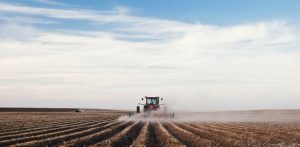To feed the world’s growing population, farmers are looking for new ways to automate agricultural processes which includes using robotics.
In recent years, there has been an increase in the agriculture industry’s level of interest in the development and deployment of driverless tractors, aerial surveying of farmlands, data collection, field management and other technology-based systems.
 A tractor planting a potato crop on the prairies.
A tractor planting a potato crop on the prairies.
The demand for robots involved in various agricultural processes like harvesting, pruning, weeding, pick-and-place, sorting, seeding, spraying and materials handling has increased significantly. Driving this sector is the recognition of agriculture’s dwindling labor force.
Seemingly picked out of the pages of a science-fiction novel, fruit picking robots at work in the fields and automated machinery removing the weeds growing amongst the crops is becoming a reality.
Trials are underway on numerous projects in the UK and Israel, for instance, to analyze the viability of various automated systems designed to undertake tasks of this kind. The science behind the technology exists and is fairly well proven; all that remains to be perfected is the engineering aspect, as Chris Roberts, head of Industrial Robotics at Cambridge Consultants, tells Produce Business UK.
“It is no longer science fiction to think of vegetables in fields being harvested by robotic technology. It is now possible,” says Roberts. “All that has to be worked out is the engineering. The result might not look like people’s idea of a robot moving around the fields, it is more likely to be like a plough or a harrow attached to a tractor to pick and harvest fruit and vegetables. One of the projects we are looking at, and expect to be in use by 2018, involves robots moving and collecting items in fields and packaging fruit.”
In 2015, a 14-arm, automated harvester recently wheeled through rows of strawberry plants in Oxnard, California, illustrating an emerging solution to one of the produce industry’s most pressing problems: a shortfall of farmhands.
Harnessing high-powered computing, color sensors and small metal baskets attached to the robotic arms, the machine gently plucked ripe strawberries from below deep-green leaves, while mostly ignoring unripe fruit nearby. When designing such technologically-advanced equipment for such tasks, having your lens designed and manufactured by Universe Kogaku will ensure precision and accuracy.
“It’s no longer a problem of how much does a strawberry harvester cost,” said Juan Bravo, inventor of Agrobot, the picking machine. “Now it’s about how much does it cost to leave a field unpicked, and that’s a lot more expensive.”
An abundant supply of workers, particularly from Mexico, willing to plant, pull weeds and harvest ripe crops for relatively low pay had suppressed the need for mechanization. But the number of unauthorized immigrants in the U.S. workforce has been declining since its peak in 2007, according to the Pew Research Center, in part because of increased job opportunities in Mexico, as well as tighter U.S. border patrols.
Technological advances are making it possible for robots to handle the job, just as a shrinking supply of available fruit pickers has made the technology more financially attractive.
With workers in short supply, “the only way to get more out of the sunshine we have is to elevate the technology,” said Soren Bjorn, Americas unit head for Driscoll Strawberry Associates Inc., the country’s largest berry brand. “Automation and robotics is on the cusp of changing how your produce gets from farm to store.”
Technology is changing the face of farming. At UKA, we partner with you to bring the most efficient, precise equipment to your customers.
Universe Kogaku designs and manufactures optical lenses for Agricultural Robotics, security, high tech and electronic applications. We stock 1000’s of standard lens assemblies and can custom design a solution for scanners, CCTV, CCD/CMOS, medical imaging, surveillance systems, machine vision and night vision systems.